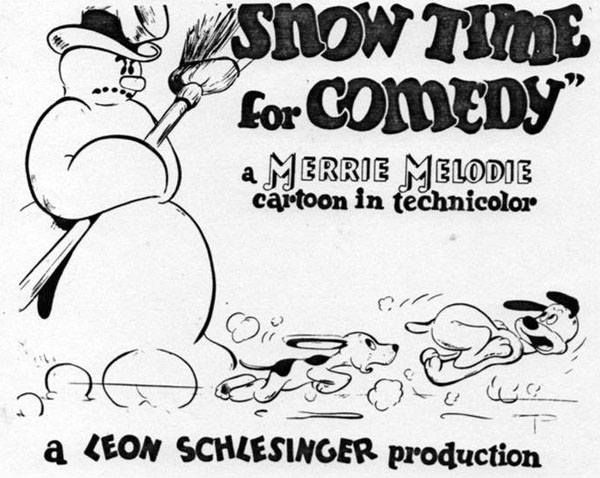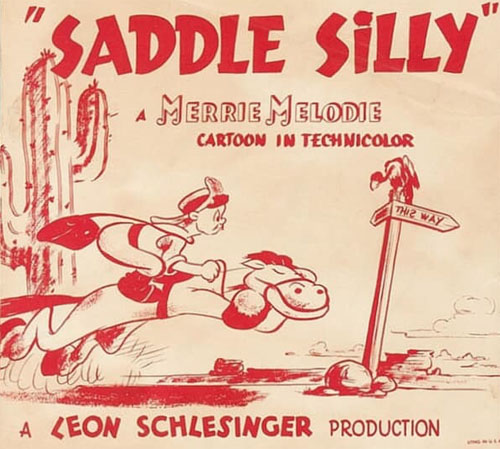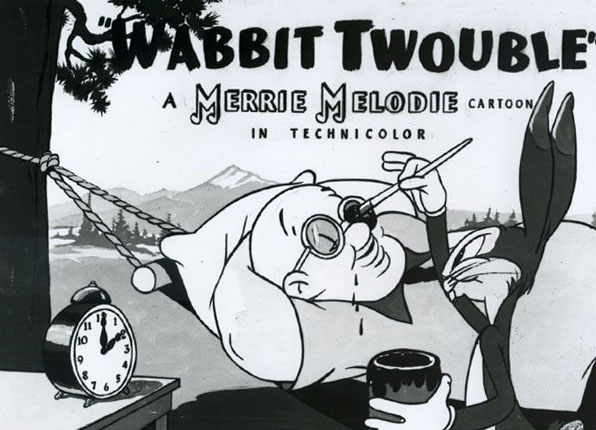The 1941-42 season saw Bugs Bunny became the main character at Warner Brothers cartons. In point of fact, he became such a popular character that the Government drafted him for a wartime bond short featuring the music of Irving Berlin – more on this matter in part 2 next time.

Snow Time For Comedy (8/30/41) – A lively romp for Chuck Jones’ two curious puppies, chasing a bone through the snow of alpine country. Sight gags abound on a ski lift, ski jump, and from the running-gag destruction (multiple times) of a beaver dam. Songs include “Keep Cool, Fool”, “What’s Your Story, Morning Glory” and a newcomer, oddly adapted by Stalling into an interesting chase riff – “The Sidewalk Serenade”, a pop tune seeming to have no film affiliation, recorded by Dick Robertson on Decca and by Sammy Kaye on Victor. The number somehow stuck in Sralling’s head for sporadic reuse, appearing again in full verse form in Tweety and Sylvester’s 1954 episode, Satan’s Waitin’ as a carnival theme.

All This and Rabbit Stew (9/13/41) – One of a handful of politically-incorrect Bugs Bunny cartoons, generally kept off the airwaves as the only one to make the official “Censored 11” list. Bugs is hunted by a Stepin Fetchit stereotype of low intellect. It appears to be the origin of a repeated gag of chasing through a hollow log and off a cliff (redrawn in whiteface for Elmer Fudd in Bob Clampett’s later episode, The Big Snooze). Bugs finds the hunter’s weakness in a pair of “African dominoes” – i.e., numbered cubes from 1 to 6. The final scene breaks down into a back street crap game, with winner (Bugs) taking all – including the one remaining fig leaf covering the hunter’s “family jewels”. Songs: ‘”Shuffle Off to Buffalo”, an original song, “I’m Gonna Get Me a Rabbit” – and “What’s Your Story Morning Glory” heard while the pair are shooting dice behind the bushes.
The Brave Little Bat (9/27/41) – Primarily notable for a full verse vocal rendition by Sniffles the Mouse of “In a Little Dutch Kindergarten”, while he tours the countryside in a wind-up toy car – the mainspring of which goes haywire, dismantling the car piece by piece, leaving Sniffles to utter the understatement of the year: “There must be something wrong with it.” Also introduces his counterpart – a small bat who just can’t stop talking – who became the new personality for Sniffles by the next episode.
The Bug Parade (10/11/41) – Spot gags on insect life, with some of Warner’s favorate comic tropes, including the auctioneer sounds of the Tobacco bug, and a cootie at the gates of an Army camp (“Millions and millions of soldiers, and they’re mine, all mine!”). Songs include “Garden of the Moon”, “The Old Gray Mare”, “If I Could Be With You” (below), “How Do You Do?” “Jeepers Creepers”, a bugle call which I associates with school recitations of the pledge of allegiance (anyone know the precise name?), and what appears to be the first use of “The Five O’Clock Whistle”, recorded heavily by the major studios – Duke Ellington on Victor with vocal by Ivie Anderson, Glenn Miller on Bluebird, Erskine Hawkins on Bluebird, Ella Fitzgerald and her Famous Orchestra on Decca, Woody Herman on Decca, Count Basie on Okeh, Ina Ray Hutton on Okeh, Will Bradley on Columbia, and much later by the George Shearing Quintet on MGM and Johnny Pate on Federal.
Rookie Review (10/25/41) – We’re not yet at war, but get spot gags on Army life anyway. Some interesting gags at mess call, with the troops of various divisions eating in styles befitting their duties (machine gunners, for example, eating peas at the same tempo as the firing of their guns, and suicide squad members eating army hash). Songs: “You’re in the Army Now”, “Reveille” and “Mess Call”, and “Garry Owen”, an Irish march which had just risen to film prominence as the regimental march for The Fighting 69th, a recent box office hit for James Cagney and Pat O’Brien. Many recordings covered the march, including O’Leary’s Irish Minstrels and Sullivan’s Shamrock Band (both for Columbia in the 1920’s), 32nd Division Band on Tell records from Europe, and even a Western version by a Canadian aggregation called Charlie Herald and his Round-Up Rangers on Bluebird (coupled with another Irish standard, “The Irish Washerwoman”), to name a few.

Saddle Silly (11/8/41) – Spot gags involving the Pony Express. A parade of Western songs and other familiars includes “Ride, Tenderfoot Ride”, “Light Cavalry Overture”, “Oh, Susanna”, “Kingdom Coming” (a song from the Civil War era, recorded as far back as Frank Crumit on Victor in 1927, and more well remembered as the whistling theme for Tex Avery’s wolf dog-catcher in The Three Little Pups (1953), and as the basis for the Sauter-Finegan Orchestra’s revival hit during the same period, “Doodletown Fifers” – see below), the Pizzicato from Sylvia, and the chase from the William Tell Overture.
The Cagey Canary (11/22/41) – Almost sets up the prototype for a Tweety and Sylvester plot, with the basic menage a trois between cat, canary, and elderly owner – except the owner is a real battle-axe, and the cat and canary still have a lot to develop in their personality before graduating to their own series. Songs include “Listen to the Mocking Bird”, first heard in minor key and then in major, “Yankee Doodle” and an early use of a Stalling favorite, “Voices of Spring” (below).
Rhapsody in Rivets (12/6/41) – The construction of a big city skyscraper from the ground up – way up – set to music. Only one musical piece is heard – but that piece is a Warner landmark. The entire film is based upon the Muller orchestration of Liszt’s “Hungarian Rhapsody No. 2″, originally written for piano. Leoposld Stokowski, probably the best known symphony conductor of his day, known for his flowing white locks and his preference of conducting without a baton, would record the orchestral version several times (one of such is embed below). In 1926-27 (a split recording date), he recorded it with the Philadelphia Orchestra for Victor. He would re-record it for the same label in 1936, then shift to Columbia records for another version in 1941 with the All American Youth Orchestra. In the early 1960‘s he conducted a stereo version, again for Victor. The 1936 version was apparently the template for Friz Freleng’s adaptation for this film – the first instance in which Freleng would have fun with the piece – though there would of course be several follow-ups in his career. The piece would even be adapted for records without the Warner orchestra as a vocal vehicle for Mel Blanc at Capitol records, providing the musical bed for Daffy Duck’s Rhapsody. Nominated for an Academy Award.

Wabbit Twouble (12/20/41) – Recently spotlighted in Animation Trails article “Toons Trip Out” on this site. Bugs and Elmer cavort and wreak havoc in a national park. The score includes a sprightly and extended aforementioned rendition of “Says Who? Says You, Says I”, from Blues in the Night; and a sped up, broken tempo rendition of the “William Tell Overture” accompanies a chase scene where Elmer and a grizzly bear fancy-maneuver through a grove of trees. There is also a ballad here – used during the sequence where Bugs switches Elmer’s glasses to a pair painted over, causing Elmer to think it’s nighttime already – that really sets the mood for Elmer’s “west and welaxation”. It’s called “The Angels Came Thru” by Ernesto Lecuona and Al Dubin (Glen Miller’s hit recording is below) and its the only time Stalling uses this tune in a cartoon.
More Merrie Melodie mayhem next time.


 James Parten has overcome a congenital visual disability to be acknowledged as an expert on the early history of recorded sound. He has a Broadcasting Certificate (Radio Option) from Los Angeles Valley College, class of 1999. He has also been a fan of animated cartoons since childhood.
James Parten has overcome a congenital visual disability to be acknowledged as an expert on the early history of recorded sound. He has a Broadcasting Certificate (Radio Option) from Los Angeles Valley College, class of 1999. He has also been a fan of animated cartoons since childhood.











































The bugle call in “The Bug Parade” is called “To the Colors”. It’s played when raising or lowering the American flag, which is why you associate it with the Pledge of Allegiance; though in the context of the cartoon, “Mess Call” would be more appropriate. (My brother was the bugler for my Boy Scout troop, and I still remember many of the calls.)
“Voices of Spring” is a great song and my favourite Strauss waltz. The vocal solo in the original (not heard in this instrumental version) is incredibly difficult, a real coloratura showcase, and a soprano needs a first-class voice to pull it off. I’m sure I’m not the only one who has vivid memories of Christine McIntyre singing “Voices of Spring” in the Three Stooges short “Micro-Phonies”.
Not to mention Dee Green massacring it in “Brideless Groom”
You could probably fill a whole post or two on uses of the Hungarian Rhapsody on cartoons. The last section is certainly well suited for orchestrating cartoon mayhem.
Wabbit Twouble is one of my favorite Bugs cartoons, and I loved the “Bugs morphing into Elmer” gag decades before it became a meme. Bonus points for including “Says Who? Says You, Says I” at the beginning- I stated previously that’s one of my favorite songs used in a LT/MM cartoon, though it’s only heard here, in Jack-Wabbit and the Beanstalk, Nutty News, and The Bird Came C.O.D.
Interesting thing about Snow Time For Comedy: The running gag of the beaver’s dam being destroyed is a perfect example of how Chuck Jones hadn’t quite found the WB humor style yet. In almost any other director’s cartoons, the beaver would probably curse up a storm or at least look increasingly peeved that its hard work keeps being destroyed. Here, it just turns its head, usually away from the camera. Doesn’t have the same comedic impact. The cartoon is very well-drawn and has the usual great Stalling soundtrack, at least- “Sidewalk Serenade” was a great choice.
Re :The Brave Little Bat,” it occurs to me that it may also be something of a takeoff on Disney’s “The Old Mill.” One interesting detail is Sniffles’s windup car appears to be a close copy of an actual tinplate toy windup car from Marx Toys known as the “Rex Racer” and sold from 1923 through the 1930’s. Perhaps one of the animators’ kids had one at home.
“The Angels Come Thru”….you have MADE my entire WEEK!! Thank YOU!!!!!
I know they’re not part of the Looney Tunes/Merrie Melodies series but are you planning to do the Private Snafu shorts as well? They have a few songs that weren’t featured in LT/MM shorts of the time that would be worth highlighting.
In “CAGEY CANARY”, during the “whistling when you’re not supposed to” (the canary holding a pretty chick pinup right in front of the cat, the trope reused in T.Avery’s “ROCKABYE BERAR” at MGM in 1952), “YOU’RE A NATURAL makes it only(?) use./. I know the song from my hotel-stylized dance band Russ Morgan CD.
And PS: That one recurring “SNOW TIME FOR COMEDY” song would have been great 1935-36 cartoon underscore! 😀
“The Doodletown Fifers” brings back pleasant memories for me because it was the theme music for a kids’ show in Chicago back in the tail end of the ’50s and into the ’70s called CARTOON TOWN or THE B.J. AND DIRTY DRAGON SHOW, hosted by cartoonist and puppeteer Bill Jackson. I never knew the source for the music but assumed it was a variation of the “Arkansas Traveller” from the old-time radio show, THE BERGEN AND McCARTHY SHOW. When Bill Jackson was selling a few of the videotaped programs he decided to preserve – it was expensive to do, back then – he wasn’t able to get permission to use this music again – which is a real shame! The “royalty fees” were too expensive!